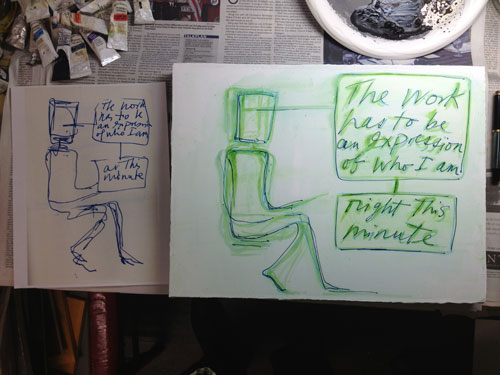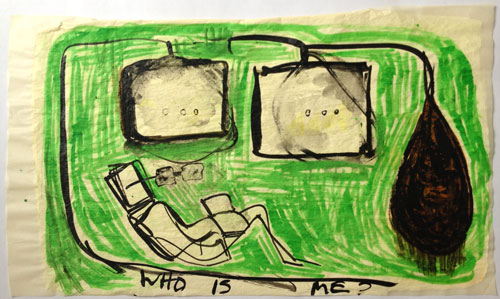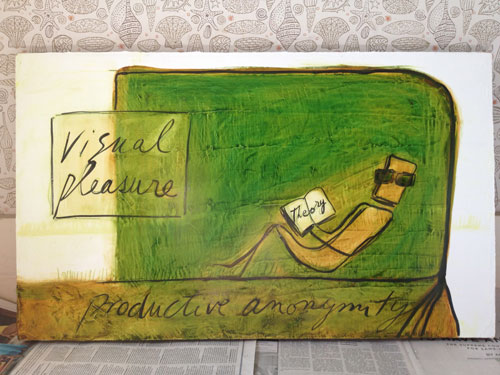July 30, 1982

Mira Schor, The Bay at 7:30PM July 30, 1982. Dry pigment, pastel, medium on rice paper, 21 x 29 1/2 in.
The Bay at 7:30 PM was included in a small show I had of Provincetown drawings from 1982-83 at artSTRAND Gallery in Provincetown in 2007. I wrote some notes on each one when I saw them on the wall:
The Bay at 7:30 PM represents a moment of perfect pleasure and balance: the perfect swim, the swimmer caught in the tremulous moment of perfection — the water is smooth, clean, reflecting pink light from the sunset. It was inspired by the beauty of a particular minute of a particular day at the end of July 1982, looking at the bay, one of those days that are a gift.
Even in 1982 this would not have been the way I would have framed an artist’s statement on this work. At that time I was relieved to feel part of a tradition of American art, that of abstracted mystical landscape, and that would have been part of a statement. But in describing it when I saw it framed and on a gallery wall for the first time in many years, I focused on the sensual response to a moment of great beauty in nature and the joy of capturing such a moment of suspension of light in time.
July 30, 2012

Mira Schor, Who is Me?, July 30, 2012. Sketchbook drawing.
I return to the sketch from earlier in the summer which I discussed a few days ago, in terms of its temporal aspects.

Mira Schor, The Work Has to Be…, July 26, 2013. Ink, rabbit skin glue on gesso on linen,12 x 16 in.
To say that the work has to be an expression of who I am, at any minute, is to point to a very subjective criterion and would indicate a very subjective art practice. That was something that was frowned upon in certain influential circles in the art world from the 80s onward, in the years of the “death of the author,” although it could be argued that any work, even the most deliberately distanced and impersonal, in fact perhaps especially work for whom claims of rigorous objectivity are made, is still an expression of who the artist is at that minute. Subjectivity and objectivity are not really in the artist’s conscious control and, if I’m talking about “authenticity,” it may not even be something that one recognizes immediately so my directive to myself is another one of those vague tricks to get working or it is the direction someone gives saying “go there” while waving generally at the horizon.
The struggle implicit in the last paragraph is part of who I am right this minute. When I did The Bay at 7:30PM in 1982, I was just poised, though I did not yet know it, to begin an immersion in a specific type of critical discourse. In the next year I began to research my essay, “Appropriated Sexuality,” on the depiction of women in the work of David Salle, and in the process, of necessity, I began a process of reeducation in postmodern theory and aesthetics, and I found myself engaged in debates between the activist approach to feminism I had been engaged in during the 70s and the psychoanalytic, textual approach that marked the 80s. “Theory” proved to be a lifesaver, not just because it was necessary to have some fluency in it to survive in the artworld during that period and if you wanted to write about the art of the time, but a lifesaver because it took me out of “myself,” at a point in my life when that was needed, and forced me to struggle with concepts in a way that provided clarity and objectivity to the place I stood in the field of contemporary art practice.

In the late ’90s, the grip of theoretical discourse began to loosen, at least in terms of art practice, pushed by a move back to the, less theorized, body and a move forward to eye candy and spectacle. But, despite this slackening of a certain kind of critical rigor, “Theory” still holds pride of place in some parts of the art academy. And it remains as important to individual artists who still stand to gain much of value for their work and their breath as artists by gaining access to a larger discourse that takes them out of themselves, especially at a time when a lot of young artists have learned to commodify themselves by some kind of Homeric identifier: I do this work because…fill in the identity. But too much of a good thing becomes an orthodoxy that offers safe pathways to professional currency but may foreclose on so many of the possibilities offered by art history and contemporary visual culture.

Mira Schor, Who is Me? July 30, 2012. Ink and gesso on tracing paper, 18 x 30 in.
The unreliability of the identity we decide to propose as our own was brought into sudden sharp focus for me many years ago. Not that I thought of it when I did this drawing, Who Is Me?, last year on July 30, (and not that I remember what exactly brought me to put those words into a drawing) but, when I was in my early 20s, I used to see a very old, very wise, half-paralyzed Russian/Viennese psychoanalyst. I said at one point something about being myself, hoping to really be myself. “Oh yes,” she said pleasantly, “who is that?” BOOM, explosions in the mind!!!
The conflict I have indicated between work that remains responsible to/restricted by critical/theoretical concerns and work that would be free to engage with visual pleasure in a less mediated way is itself an unreliable portrait of “myself.” I can’t possibly separate the intellectual from the visual. Even when I stick my nose in the earth, I’m doing it because I’m inspired by a text I’m reading (see my discussion of Silvia Federici’s book Caliban and the Witch in my previous post).

Mira Schor, Fallow Field Series: Deep Communication with the Earth, July 30, 2012. Ink and gouache on tracing paper
14 x 18 in.

July 30, 2013
Nevertheless, “during theory,” I purposefully policed my use of painting “effects”–bits of virtuosity, swirls of paint, rich color just for the sake of it as opposed to being part of a conceptual program. Yet I was doing exactly what I thought was right for the work, and my stern editing of such effects was and I think it still is part of a search for formal clarity and at the same time I couldn’t help myself from putting paint on in ways that gave me visual and material pleasure.
Today was as perfect a day as July 30, 1982. But the visual particulars of the place itself, Provincetown, is not the object matter of the work today. The “place” in the painting is based on the real but it is transformed into a situation, a shallow proscenium in which to diagram thought and the impact of theoretical concerns on visual practice. This is a work in process in the studio:

Mira Schor, Visual Pleasure/Theory/Productive Anonymity, July 30, 2013. Ink, oil on gesso on linen, 18 x 30 in. Work in process

Reminder: I will return to posting on art, culture, and politics soon enough but I hope my subscribers and readers will allow me a slight summer detour, a project of posting works done on specific summer days from different years, begun July 13.
